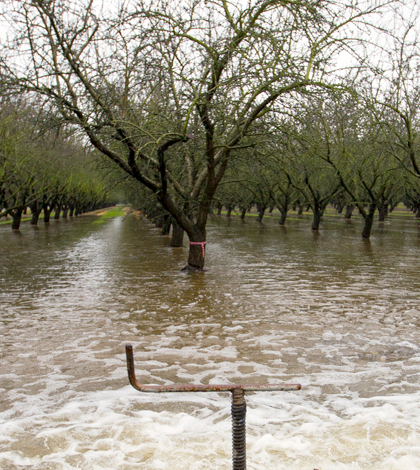Managed Aquifer Recharge Vetted As Tool To Fight Drought

University of California, Davis scientists take full advantage of El Niño rains as they deliberately flood part of an almond orchard outside Modesto, California as part of a groundwater banking experiment. (Credit: Joe Proudman / University of California, Davis)
Managed aquifer recharge isn’t a new idea. But it is one that could hold a lot of potential for helping the state of California deal with ongoing drought conditions. The state has been fighting with drought for the past five years, and though El Niño has brought some recent relief, there are still continuing dry conditions to contend with.
The reason that managed aquifer recharge is a good option to help deal with drought is because it can work within systems that already exist for controlling flood risks in California. In addition to that, the technique’s setup acknowledges that a future filled with drought and low snowpack is likely within climate changes predicted to come.
In simple terms, recharging aquifers could be done by diverting waters from reservoirs filled up with excess runoff. The water could then be pumped to areas with the right mix of soils and plants to maximize the recharge of aquifers below.
Researchers at the University of California, Davis, are trying to assess the viability of managed aquifer recharge as a management tool. Though the approach seems promising, they cannot yet guarantee its effectiveness in terms of overall benefits.
“Right now, we’re mostly looking at what soils are suitable. If we negatively impact crops or reduce yields, that’s not good for farmers,” said Helen Dahlke, assistant professor in the Department of Land, Air and Water Resources at the university. “We need to first prove that we’re not doing any harm.”
To do that, she and others at the university are running several experiments looking at the receptivity of different crops and soils to aquifer recharge. A few, in Delhi and Modesto, are taking place at almond orchards. The fields are flooded with excess rainwater during colder months when the trees are dormant and don’t take up the water, allowing for extra percolation to the aquifer below.

Helen Dahlke stands in a deliberately flooded almond orchard outside Modesto, California. (Credit: Joe Proudman / University of California, Davis)
In the interim, scientists have instrumented the trees with a number of sensors for assessing their health, as well as that of the surrounding soil. These include sensors for measuring water level and soil moisture, temperature and conductivity. Cores of the soil are also taken so that researchers can determine what constituents the earth is made of.
Another one involves the use of Plexiglas tubes inserted into the ground near the roots of the trees. When the roots grow far enough, they hit the sides of the tubes and can then be tracked by underground cameras. Astrid Volder, assistant professor in the Department of Plant Sciences, is heading up this effort.
“They grow along the sides of the tube and we can take a picture every week with a special camera in the tube,” said Dahlke. “We can see how many roots there are, the growth. If they’re not growing, it indicates that the trees are dormant or very inactive.”
Measurements of the tree’s yield are also important, she notes, so some of her colleagues are tracking how the trees’ almonds grow. They consider the blooms and blossoms that come off each tree, but also the fruit.
“Also the stem water potential. There’s a certain water potential in the tree trunk, its stems and leaves, that is related to how the tree is stressed or not,” said Dahlke. Her colleague Ken Shackel, a professor of Plant Sciences, is overseeing those measurements.
She is also involved in projects that are looking at other field types, like those used for growing alfalfa and pistachios, to see how they respond to the method.
“We’re trying to branch out into different agricultural crops, soils and landscapes,” said Dahlke. “What soils are really suitable in practice? We want to understand where the practice is feasible in the long term and where it’s not.”
Part of this work is reflected in the Soil Agricultural Groundwater Banking Index, a tool developed by Toby O’geen, a soil resource specialist at the university, that allows users to enter an address to see what types of soils are there and if the location might be a good prospect for managed aquifer recharge treatment.
In many of the experiments she’s worked on, the tool’s predictions have been proven correct, she says. But for the almond plots in Delhi and Modesto, that remains to be seen.
“The root pics did not indicate active root growth. We’ll have to wait for the yield data,” said Dahlke. “We have looked at stem pressure and can see some differences. It looks like it had a beneficial effect, but this all has to be confirmed by leaf-out or yield data in the summer. It’s promising, but there’s no guarantee yet.”
Top image: University of California, Davis scientists take full advantage of El Niño rains as they deliberately flood part of an almond orchard outside Modesto, California as part of a groundwater banking experiment. (Credit: Joe Proudman / University of California, Davis)





Jim Amon
February 26, 2016 at 3:49 pm
Here in Beaver Creek Wetlands territory we are concerned with groundwater recharge because it not only provides drinking water to the community, but also supplies the wetlands with essential groundwater. I would like to see many developers use a similar system in their retention/detention ponds to mitigate the losses caused by so much hard surface. We are however concerned about the lawn fertilizers entering that supply.